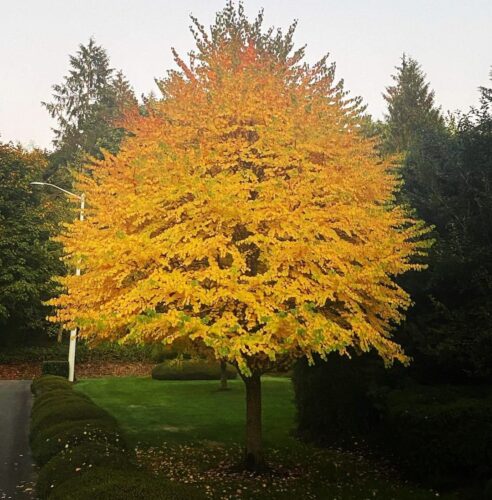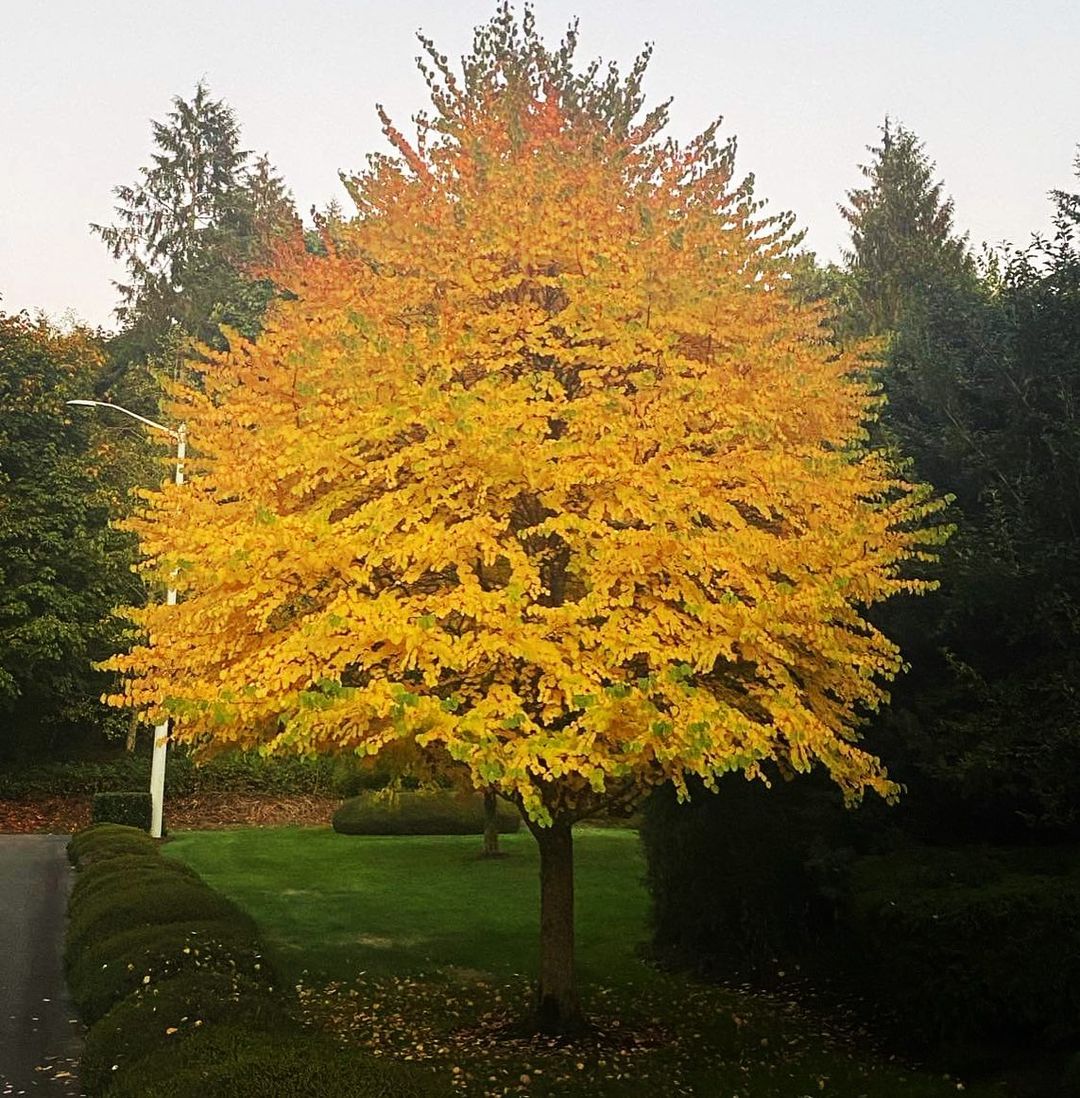Katsura Tree is a low-maintenance, deciduous tree with a pyramidal growth habit. It is a great choice for golf courses, parks, and streets.
Katsura trees usually have many trunks when they grow on their own, but garden stores often shape and sell them to have just one trunk. The roots are thick and spread near the surface of the soil, which looks nice but can cause problems for sidewalks and mowing nearby. Read more about Katsura Tree in this post.
USDA Zones: 4-8
Read: Invasive Trees Avoid Planting in Your Yard
Katsura Tree Information

Katsura trees (Cercidiphyllum japonicum) are big shade trees that come from Japan. When they’re young, they grow quite quickly, but as they get older, their growth slows down. Young trees have a nice pyramid or oval shape, which becomes more upright and spread out as they get older (female trees spread more than male trees). The leaves are shaped like hearts and start off bronze in spring, then turn blue-green in summer, and finally change to warm shades of orange and golden-yellow in fall.
The leaves look a bit like those of redbud trees and make a nice contrast to the pointy leaves of maple and oak trees.
Propagating Katsura Tree
You can grow Katsura trees from semi-hardwood cuttings. In the middle of summer, cut a stem near the bottom, about half an inch below the node. Dip the cut end into rooting hormone powder and plant it in a 4-inch pot filled with moist potting soil, making sure to bury the node completely.
Put a clear plastic dome or a plastic bag over the pot. Keep the pot in a place with lots of light but not where the sun shines directly on it. Water it regularly so the soil stays moist. When you see new leaves growing and the cutting stays in place when you gently pull on it, take off the cover.
Allow the plant to grow strong and healthy for at least another year before planting it outside. Leave the pot outside during the winter, but make sure to protect the roots from the cold by burying the pot in the ground until spring.
Types of Katsura Tree
1. ‘Morioka’ Weeping Katsura ( Zones 4-8)
It can grow up to 30-50 feet tall and 30 feet wide. Young trees have a vertical form and turn weeping with maturity.
2. ‘Heronswood Globe’ Katsura ( Zones 5-8)
This compact, bushy tree usually grows between 8 to 15 feet tall, but sometimes it can reach up to 20 feet. In the summer, it produces lots of green-blue leaves. In the fall, they turn bright yellow or red.
3. ‘Pendula’ Weeping Katsura ( Zones 4-8)
‘Pendula’ can reach up to 15-25 feet tall and 20-25 feet wide. This variety shows off a weeping growth pattern.
Where to Plant a Katsura Tree
Choose a spot where the tree can get lots of sunlight, but some shade is also fine. Make sure the soil is moist and drains well. Katsura trees can grow in soil that’s slightly acidic or alkaline.
When planting a katsura tree, it’s important to have plenty of space, considering both the tall height and wide canopy of the tree when it’s fully grown. The surface roots, which can grow up to 6 inches thick, can cause issues earlier on by lifting nearby sidewalks, creating obstacles for walking, and making mowing hard. Rather than trying to grow grass under the tree, it’s better to cover the soil beneath its canopy with a 2-inch layer of mulch all year round.
The wood of the katsura tree is not very strong and can easily break. If you can, plant it where it is protected from strong winds and keep it a good distance away from paths or driveways. Broken branches from the tree can be dangerous.
How and When to Plant a Katsura Tree
Plant your katsura tree in spring or early summer. Dig a hole that is at least twice as wide and deep as the root ball of the tree. Place the tree in the hole so the top of the root ball is level with the ground. Fill the hole with the soil you dug out and press it down firmly. Water the tree thoroughly right after planting, and make sure to keep the soil around the young tree moist. Spread a 2-inch layer of mulch over the soil above the root ball to help retain moisture. Make sure to plant the trees at least 40 feet apart.
Ideal Growing Conditions for Katsura Tree
Light
Katsura trees prefer full sun to partial shade. In southern regions, this tree grows away from the harsh afternoon sun.
Soil
Katsura trees grow well in rich, moist, and well-draining soil. They can grow in clay, loam, or sand. This tree can handle soil that is slightly acidic to slightly alkaline, between pH 5.0 and 8.2.
Water
These trees don’t handle drought well, especially when they’re young. After planting, make sure to water them regularly, giving about 10 gallons of water each week to help their roots grow deep and spread out. In the second year, you can reduce watering. When there’s a long dry spell, make sure to water established trees.
Temperature and Humidity
Katsura trees belongs to areas with cold winters and warm summers. They can handle some humidity when the weather is cool to moderately warm, but they don’t do well in hot, dry conditions.
Read: Rudraksha Tree Care
Katsura Tree Care
Fertilizer
If you plant katsura trees in fertile, nutrient-rich soil, you usually won’t need to use fertilizer. However, if the soil is poor and needs extra nutrients, wait until the tree is established, usually about a year after planting, before applying fertilizer. Use a slow-release tree and shrub fertilizer in early spring.
Pruning
Each year, during late winter, trim the tree to get rid of branches that are crossing, rubbing against each other, or growing where they shouldn’t. As the tree gets older, you might need to cut down more drooping branches that get in the way of people walking or vehicles passing by.
Repotting
Katsura Tree are too large to be planted in containers.
Pests and Diseases
This tree doesn’t usually have any serious problems with pests or diseases. However, during dry summers, it might lose its leaves earlier than usual. It displays bad leaf color in alkaline soil.
Read: Ice Cream Bean Tree Care
Katsura Tree Companion Plants
Magnolia (Magnolia grandiflora L.)
When planted alongside a magnolia, a katsura tree can form a natural barrier. Finding a suitable magnolia to pair with your katsura tree shouldn’t be hard, as there are many options available, including shrubs, dwarf trees, and tall trees that grow in almost every climate zone. Just remember to give the magnolia enough room to grow, as it doesn’t like being cramped. This combination is suitable in zones 4 to 10.
Paperbark Maple (Acer griseum)
Acer griseum is a maple species from China that grows very slowly. It can eventually grow up to 30 feet tall and wide. Its bark peels off in orange-brown strips, similar to a river birch tree. The leaves turn red-orange in the fall. It grows in zones 4 to 8.
Northern Red Oak (Quercus rubra)
This variety of oak trees is found naturally in the eastern and central United States, as well as in parts of southeast and south-central Canada. It can reach heights of up to 80 feet and spread out to 70 feet wide. During the fall season, the leaves turn into a beautiful mix of yellow and red. This oak species grows well in zones 5 to 9.



